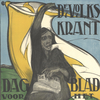Meten van verzuilde politiek in media
Een digitale benadering van katholieke en sociaaldemocratische dagbladen, 1918-1967
DOI:
https://doi.org/10.51769/bmgn-lchr.6916Keywords:
Dutch History, Media History, Political History, Digital HumanitiesAbstract
Sinds het einde van de vorige eeuw houden mediahistorici zich meer bezig met de manier waarop media-inhoud tot stand is gekomen en welke betekenis dat heeft gehad voor publieksgroepen en maatschappelijk-politieke realiteiten. In dit artikel wordt gepoogd deze benadering te combineren met digital history, aan de hand van het verzuilingsdebat en gebruik makend van de digitale krantencollectie van de Koninklijke Bibliotheek van Nederland. Enerzijds wordt onderzocht in hoeverre de veronderstelde ideologische gebondenheid van dagbladen in de jaren 1918-1967 zichtbaar wordt in de hoeveelheid kopij waarmee katholieke en sociaaldemocratische kranten over politiek hebben bericht en hoe verschillen daarin te verklaren zijn. Anderzijds wordt door het testen van kwantitatieve methoden uit de digital humanities geprobeerd een bijdrage te leveren aan digitale bronnenkritiek voor historisch onderzoek.
Since the end of the last century media historians have taken an interest in researching the origins and development of media content and its significance for audiences and socio-political realities. This article seeks to combine this approach with digital history. It does so by focusing on the pillarisation debate and by utilising the digital newspaper collection of the National Library of the Netherlands. On the one hand, this article investigates to what extent the ideological background of the Catholic and Social Democratic press is actually reflected in the number of newspaper articles reporting on politics written between 1918-1967, and how any differences can be explained. On the other hand, by testing quantitative methods from the digital humanities, the article attempts to contribute to digital source criticism for historical research.
Actualiteitsparagraaf
Hoe meet je een zuil?
Met digitale methoden de verzuiling te lijf
Groepsvorming op maatschappelijk niveau, zoals de hedendaagse ‘social media bubbles’, is van alle tijden. Voor Nederland was de verzuiling lange tijd kenmerkend. Identiteitsgevoelige gemeenschappen op religieuze en politieke basis organiseerden de samenleving en beheersten de politiek. Kunnen we meten wat de functie van media in zo’n zuil is, nu steeds meer digitale historische bronnen beschikbaar zijn? Huub Wijfjes, Gerrit Voerman en Patrick Bos bestudeerden voor BMGN 136:3 tientallen miljoenen gedigitaliseerde krantenartikelen uit de hoogtijdagen van de verzuiling, tussen 1918 en 1967. Met behulp van digital humanities methoden, gingen ze op zoek naar de veronderstelde zuilloyaliteit van kranten. Dat onderzoek spitste zich toe op de katholieke en socialistische zuilen. Met combinaties van zoekwoorden (woorden die relevant waren voor uitdrukken van ideologische, politieke, of organisatorische verbondenheid) werd de kranteninhoud statistisch geanalyseerd. Hieruit komt een beeld naar voren van de politieke strijd tussen katholieken en socialisten. Kranten waren er niet alleen voor bevestiging van de eigen identiteit, maar ook de bestrijding van de tegenstander. Opmerkelijk is dat ook de manier waarop die strijd door de twee zuilen gevoerd werd duidelijk te kwantificeren blijkt: door de socialisten vooral via politiek en ideologie, door de katholieken nadrukkelijk via brede sociaal-culturele inbedding in het dagelijks leven.
Downloads

Downloads
Published
Issue
Section
License
Copyright (c) 2021 Huub Wijfjes, Gerrit Voerman, Patrick Bos

This work is licensed under a Creative Commons Attribution 4.0 International License.
Authors who publish with this journal agree to the following terms:
a) Authors retain copyright and grant the journal right of first publication with the work simultaneously licensed under a Creative Commons Attribution 4.0 International (CC BY 4.0) that allows others to share the work with an acknowledgement of the work's authorship and initial publication in this journal.
b) Authors are able to enter into separate, additional contractual arrangements for the non-exclusive distribution of the journal's published version of the work (e.g., post it to an institutional repository or publish it in a book), with an acknowledgement of its initial publication in this journal.
c) Authors are permitted to post their work online (e.g., in institutional repositories or on their website) prior to and during the submission process.
Authors are explicitly encouraged to deposit their published article in their institutional repository.











